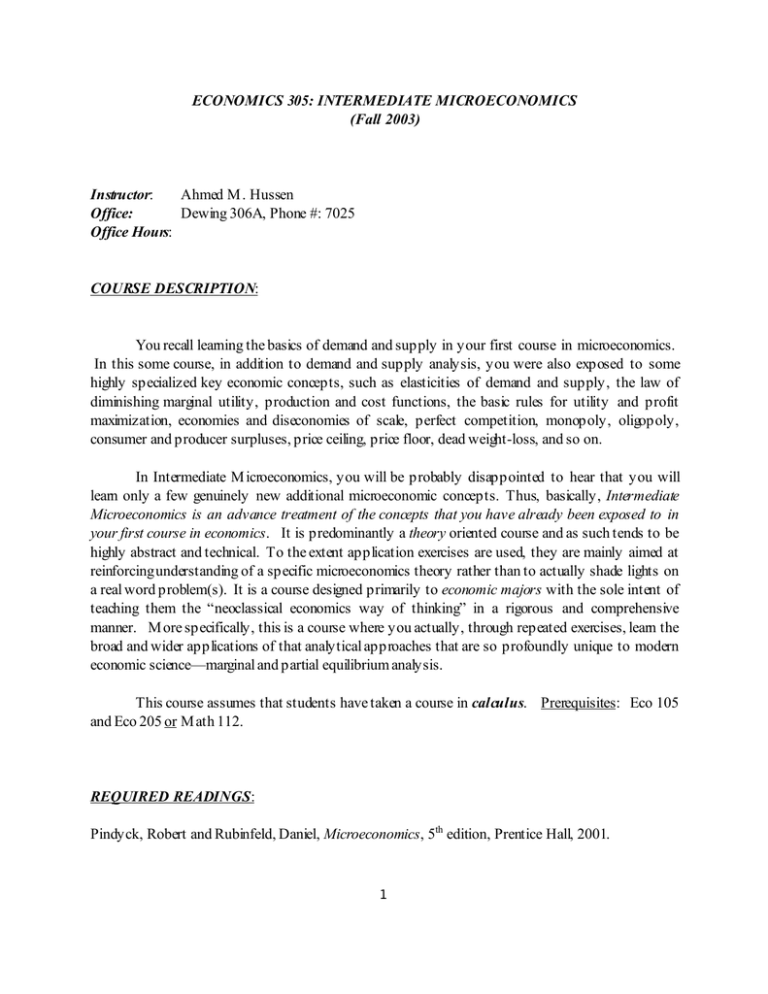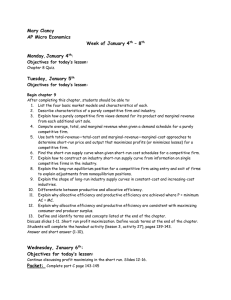Ahmed M . Hussen Dewing 306A, Phone #: 7025
advertisement

ECONOMICS 305: INTERMEDIATE MICROECONOMICS (Fall 2003) Instructor: Ahmed M . Hussen Office: Dewing 306A, Phone #: 7025 Office Hours: COURSE DESCRIPTION: You recall learning the basics of demand and supply in your first course in microeconomics. In this some course, in addition to demand and supply analysis, you were also exposed to some highly specialized key economic concepts, such as elasticities of demand and supply, the law of diminishing marginal utility, production and cost functions, the basic rules for utility and profit maximization, economies and diseconomies of scale, perfect competition, monopoly, oligopoly, consumer and producer surpluses, price ceiling, price floor, dead weight-loss, and so on. In Intermediate M icroeconomics, you will be probably disappointed to hear that you will learn only a few genuinely new additional microeconomic concepts. Thus, basically, Intermediate Microeconomics is an advance treatment of the concepts that you have already been exposed to in your first course in economics. It is predominantly a theory oriented course and as such tends to be highly abstract and technical. To the extent application exercises are used, they are mainly aimed at reinforcing understanding of a specific microeconomics theory rather than to actually shade lights on a real word problem(s). It is a course designed primarily to economic majors with the sole intent of teaching them the “neoclassical economics way of thinking” in a rigorous and comprehensive manner. M ore specifically, this is a course where you actually, through repeated exercises, learn the broad and wider applications of that analytical approaches that are so profoundly unique to modern economic science—marginal and partial equilibrium analysis. This course assumes that students have taken a course in calculus. Prerequisites: Eco 105 and Eco 205 or M ath 112. REQUIRED READINGS: Pindyck, Robert and Rubinfeld, Daniel, Microeconomics, 5th edition, Prentice Hall, 2001. 1 Additional readings will be placed on reserve in the Library as needed. LECTURE OUTLINE: PART I THE THEORY OF CONS UMER CHOICE: Output Demand and Input S upply The Theory of Consumer Choice: A Schematic View Consumer Preference • Utility Maximization • Demand for Final Goods and Services Supply for Factors of Production • Labor • Savings Budget Constraint Part I, the theory of consumer choice, deals with every day decisions a rational and wellinformed consumer makes, such as on how much of her/his monthly income to spend for buying food or other consumption goods and services; how much time to spend working or relaxing; and how much to save. These decisions, as implied by the above diagram, are done after careful consideration of the preference function, budget constraint and utility maximizing behavior of the individual consumer. As implied by the entries in the last box of the above diagram, it is also out of this intellectual exercises that generalized theories of consumer demand for final goods and services and supply for a factor of production, such as labor are derived. A. The Choice of the Optimal Consumption Bundle Week 1: Chapter 3 ( pp. 51 – 84; 89-91) • The Economic World: Basic Assumptions 2 • • • Utility and Choice The Equi-marginal Condition for Utility M aximizing Consumption Choice Applications B. From the Theory of Choice to the Theory of Consumer Demand Week 2 : Chapter 4 (pp. 101-126; 131-135), Appendix to Chapter 4 (pp.139-147) • • • • • • Changes in Income and Consumer’s Choice: Engel’s Law Changes in Price and Consumer’s Choice: Derivation of Individual Demand Curve From the Individual to M arket Demand M arket Demand and Elasticity Consumer Surplus Applications C. The Consumption-Leisure Choice and the Choice to Save or Borrow Week 3: Chapter 14 (pp. 509-513) • • • • • The Consumption-Leisure Choice Derivation of the Labor Supply Curve Consumer’s Time Preference The Optimal Saving Mid-term Exam I End of Part I 3 PART II: THE THEORY OF THE FIRM: Output S upply and Input Demand The Theory of the Firm Budget Constraints • Profit Maximization • Supply for Final Goods and Services Demand for factors of Production • Labor • Capital Production Technologies Part II, the theory of the firm, deals with how a business entity with a singular objective to maximize profit makes decisions, such as on how many units of output to produce and workers or some other factor of productions to use in its daily business dealings. This is done, as indicated in the diagram above after careful considerations of the firm’s technological options (which determines the structure of the cost of production), budget constraint and profit maximizing behavior. This basic theory of the firm is the cornerstone for the neoclassical theories of supply for final goods and services and the demand for factors of production (see the last box in the above diagram). A. The Nature and Scope of the Technological Option of the Firm 4 Week 4: Chapter 6 (pp. 177-201) • • • • • • • • The Firm and Its Objectives The Production Technology of the Firm: Production Functions The Law of Diminishing M arginal Productivity The Concept of an Isoquant and Input Substitution Returns to Scale Technical Progress versus Input Substitution The Cobb-Douglas Type Production Functions and their Properties Applications B. The Optimal Input Choice of the Firm Week 5: Chapter 7 (pp. 203-208; 215-224) • • • • Basic Concepts of Costs Short-run versus Long-run The Equi-M arginal Condition for Cost M inimization—Optimal Input Choice The Expansion Path of a Competitive Firm C. From Input Choice to the Theory of Production Cost Week 6: Chapter 7 (pp. 224-229; 208-215), Appendix to Chapter 7 (pp. 246-250) • • • • • Derivation of the Long-run Cost Curve of a Firm General Features of Long-run Cost Functions and their Explanations The Link Between Short-run and Long-run Cost Functions The Conventional Short-run Cost Function The Basic Features of Short-run Cost Curves and their Properties D. Optimal Output Choice and the Theory of Supply Week 7: Chapter 8 (pp. 251-271) 5 • • • • • • The Nature of the Firm’s Marginal Revenue Function The Equi-M arginal Condition for Profit M aximizing Output Choice The Short-Run Supply Curve of a Competitive Firm The Short-Run M arket Supply Curve Factors Affecting the Short-Run Supply Curve Short-run Price Determination E. Optimal Output Choice and the Theory of Input Demand Week 8: Chapter 14 (pp. 501-509; 514-518) • • • • • • Profit-M aximizing Behavior and the Hiring of Inputs The Demand for Labor: A single Variable Input Case Two Variable Input Case Factors Affecting the Demand for Labor Equilibrium in the Labor M arket Mid-term Exam II PART III PRICING AND OUTPUT DECISION UNDER ALTERNATIVE MARKET S TRUCTURES Parts I and II together thoroughly and systematically examined the neoclassical theories of demand and supply (for both the product and factor markets). This investigation was done assuming a perfectly competitive market structure. Part III, which in some respect is an extension of Parts I and II, deals with two pertinent issues. It starts with a comprehensive evaluation of the performance of a perfectly competitive market system in the long-run—the so-called Adam Smith’s Invisible Hand Theorem. The second issue deals with the effects of market imperfections on the pricing, production and employment decisions of a firm and what these outcomes might suggest to the efficiency by which resources allocated for society at large. A. Pricing in Markets of Perfect Competition and Monopoly: An Evaluative Approach 6 Week 9: Chapter 8 (pp. 271-277), Chapter 16 (pp. 590-593), Chapter 10 (pp. 327-351; 359-362), Chapter 11 (369-381) • • • • • • • The Competitive M arket: the Best of all Worlds! M onopoly Power Pricing and Output Decision of a M onopoly Efficiency Loss and Income Redistribution Effects of M onopoly Pricing Price discrimination and for what purpose! Alternative Public Policy to Regulate M onopoly Pricing Practices A Natural M onopoly and its Regulations B. Pricing in Markets that Fall between the Polar Extremes of Perfect Competition and Monopoly Week 10: Chapter 12 (pp. 323-330; 442-448), Chapter 13 (pp. 461467) • • • • Pricing and Output Decision Under M onopolistic Competition Oligopolistic M arket Structure Strategy and Game Theory Concluding Remark GRADING: Two M id-term Exams................... Final Exam......................... Quiz and Other Class Assignments 60% 30% 10% IMPORTANT NOTE: Any student with a disability who needs an accommodation or other assistance in this course should make an appointment to speak with me as soon as possible. 7





